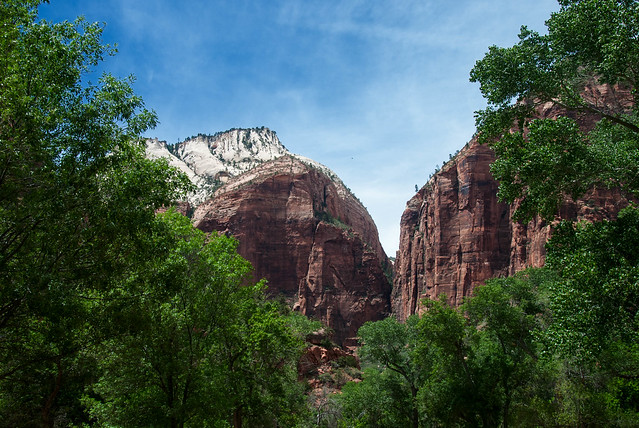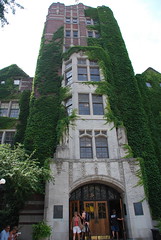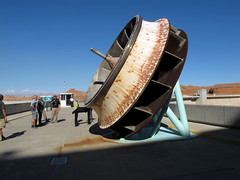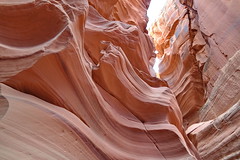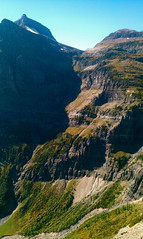North America
North America is a continent in the Northern Hemisphere and almost entirely within the Western Hemisphere. It is bordered to the north by the Arctic Ocean, to the east by the Atlantic Ocean, to the southeast by South America and the Caribbean Sea, and to the west and south by the Pacific Ocean. Because it is on the North American Tectonic Plate, Greenland is included as a part of North America geographically.
North America covers an area of about , about 16.5% of Earth's land area and about 4.8% of its total surface area. North America is the third-largest continent by area, following Asia and Africa, and the fourth by population after Asia, Africa, and Europe. In 2013, its population was estimated at nearly 579 million people in 23 independent states, or about 7.5% of the world's population. In human geography and in the English-speaking world outside the United States, particularly in Canada, "North America" and "North American" can refer to just Canada and the United States together.
North America was reached by its first human populations during the Last Glacial Period, via crossing the Bering land bridge approximately 20,000 to 17,000 years ago. The so-called Paleo-Indian period is taken to have lasted until about 10,000 years ago (the beginning of the Archaic or Meso-Indian period). The classic stage spans roughly the 6th to 13th centuries. The first recorded Europeans to visit North America (other than Greenland) were the Norse around 1000 AD. Christopher Columbus's arrival in 1492 sparked a transatlantic exchange which included migrations of European settlers during the Age of Discovery and the early modern period. Present-day cultural and ethnic patterns reflect interactions between European colonists, indigenous peoples, African slaves, immigrants from Europe, Asia, and the descendants of these groups.
Owing to Europe's colonization of the Americas, most North Americans speak European languages such as English, Spanish or French, and their cultures commonly reflect Western traditions. However, in parts of Canada, the United States, Mexico, and Central America, there are indigenous populations continuing their cultural traditions and speaking native languages.
Name
The Americas are usually accepted as having been named after the Italian explorer Amerigo Vespucci by the German cartographers Martin Waldseemüller and Matthias Ringmann. Vespucci, who explored South America between 1497 and 1502, was the first European to suggest that the Americas were not the East Indies, but a different landmass previously unknown by Europeans. In 1507, Waldseemüller produced a world map, in which he placed the word "America" on the continent of South America. What was known about the continent was referred to as Parias above what is today Mexico. On a 1553 world map published by Petrus Apianus, North America was called Baccalearum, meaning "realm of the Cod fish", in reference to the abundance of Cod fish on the east coast.
Waldseemüller used the Latinized version of Vespucci's name (Americus Vespucius), but in its feminine form "America", following the examples of "Europa", "Asia" and "Africa". Later mapmakers extended the name America to the northern continent. In 1538, Gerard Mercator used America on his map of the world for the entire Western Hemisphere.
Gerardus Mercator on his map called North America "America or New India" (America sive India Nova). The Spanish Empire called its territories in North and South America "Las Indias"; the state body overseeing them was the Council of the Indies.
Extent
The United Nations formally recognizes "North America" as comprising three areas: Northern America, Central America, and the Caribbean. This has been formally defined by the UN Statistics Division.
"Northern America", as a term distinct from "North America", excludes Central America, which itself may or may not include Mexico. In the limited context of the North American Free Trade Agreement (NAFTA), the term covers Canada, the United States, and Mexico, which are the three signatories of that treaty.
France, Italy, Portugal, Spain, Romania, Greece, and the countries of Latin America use a six-continent model, with the Americas viewed as a single continent and North America designating a subcontinent comprising Canada, the U.S., Mexico, and Saint Pierre et Miquelon (politically part of France), and often Greenland, and Bermuda.
North America has been historically referred to by other names. Spanish North America (New Spain) was often referred to as Northern America, and this was the first official name given to Mexico.
Regions
Geographically, the North American continent has many regions and subregions. These include cultural, economic, and geographic regions. Economic regions included those formed by trade blocs, such as those of the NAFTA and Central American Free Trade Agreement (CAFTA). Linguistically and culturally, the continent could be divided into Anglo-America and Latin America. Anglo-America includes most of Northern America, Belize, and Caribbean islands with English-speaking populations (though sub-national entities, such as Louisiana and Quebec, have large Francophone populations; in Quebec, French is the sole official language.
The southern part of the North American continent is composed of two regions. These are Central America and the Caribbean. The north of the continent maintains recognized regions as well. In contrast to the common definition of "North America", which encompasses the whole continent, the term "North America" is sometimes used to refer only to Mexico, Canada, the U.S., and Greenland.
The term Northern America refers to the northernmost countries and territories of North America: the U.S., Bermuda, St. Pierre and Miquelon, Canada, and Greenland.Although the term does not refer to a unified region, Middle America—not to be confused with the Midwestern U.S.—groups the regions of Mexico, Central America, and the Caribbean.
North America's largest countries by land area, Canada and the U.S., also have well-defined and recognized regions. In the case of Canada, these are (from east to west) Atlantic Canada, Central Canada, Canadian Prairies, the British Columbia Coast, and Northern Canada. These regions also contain many subregions. In the case of the U.S.—and in accordance with the U.S. Census Bureau definitions—these regions are: New England, Mid-Atlantic, South Atlantic states, East North Central states, West North Central states, East South Central states, West South Central states, Mountain states, and Pacific states. Regions shared between both nations include the Great Lakes region. Megalopolises have formed between both nations in the case of the Pacific Northwest and the Great Lakes Megaregion.
Countries, dependencies, and other territories
| Arms | Flag | Country / Territory | Area | Population | Population density | Capital | Name(s) in official language(s) | ISO 3166-1 |
|---|---|---|---|---|---|---|---|---|
| Anguilla (United Kingdom) | The Valley | Anguilla | AIA | |||||
| Antigua and Barbuda | St. John's | Antigua and Barbuda | ATG | |||||
| Aruba (Kingdom of the Netherlands) | Oranjestad | Aruba | ABW | |||||
| The Bahamas | Nassau | Bahamas | BHS | |||||
| Barbados | Bridgetown | Barbados | BRB | |||||
| Belize | Belmopan | Belize | BLZ | |||||
| Bermuda (United Kingdom) | Hamilton | Bermuda | BMU | |||||
| Bonaire (Kingdom of the Netherlands) | 12,093 | Kralendijk | Boneiru | BES | ||||
| British Virgin Islands (United Kingdom) | Road Town | British Virgin Islands | VGB | |||||
| Canada | Ottawa | Canada | CAN | |||||
| Cayman Islands (United Kingdom) | George Town | Cayman Islands | CYM | |||||
| Clipperton Island (France) | 0 | — | Île de Clipperton | CPT | ||||
| Costa Rica | San José | Costa Rica | CRI | |||||
| Cuba | Havana | Cuba | CUB | |||||
| Curaçao (Kingdom of the Netherlands) | Willemstad | Kòrsou | CUW | |||||
| Dominica | Roseau | Dominica | DMA | |||||
| Dominican Republic | Santo Domingo | República Dominicana | DOM | |||||
| El Salvador | San Salvador | El Salvador | SLV | |||||
| Federal Dependencies of Venezuela (Venezuela) | 2,155 | Gran Roque | Dependencias Federales de Venezuela | VEN-W | ||||
| Greenland (Kingdom of Denmark) | Nuuk | Kalaallit Nunaat/Grønland | GRL | |||||
| Grenada | St. George's | Gwinàd | GRD | |||||
| Guadeloupe (France) | Basse-Terre | Gwadloup | GLP | |||||
| Guatemala | Guatemala City | Guatemala | GTM | |||||
| Haiti | Port-au-Prince | Ayiti/Haïti | HTI | |||||
| Honduras | Tegucigalpa | Honduras | HND | |||||
| Jamaica | Kingston | Jumieka | JAM | |||||
| Martinique (France) | Fort-de-France | Martinique/Matinik | MTQ | |||||
| Mexico | Mexico City | México | MEX | |||||
| Montserrat (United Kingdom) | Plymouth, Brades | Montserrat | MSR | |||||
| Nicaragua | Managua | Nicaragua | NIC | |||||
| Nueva Esparta (Venezuela) | 491,610 | La Asunción | Nueva Esparta | VEN-O | ||||
| Panama | Panama City | Panamá | PAN | |||||
| Puerto Rico (United States) | San Juan | Puerto Rico | PRI | |||||
| Saba (Kingdom of the Netherlands) | 1,537 | The Bottom | Saba | BES | ||||
| San Andrés and Providencia (Colombia) | 77,701 | San Andrés | San Andrés | COL-SAP | ||||
| Saint Barthélemy (France) | 7,448 | Gustavia | Saint-Barthélemy | BLM | ||||
| Saint Kitts and Nevis | Basseterre | Saint Kitts and Nevis | KNA | |||||
| Saint Lucia | Castries | Sainte-Lucie | LCA | |||||
| Saint Martin (France) | 29,820 | Marigot | Saint-Martin | MAF | ||||
| Saint Pierre and Miquelon (France) | Saint-Pierre | Saint-Pierre-et-Miquelon | SPM | |||||
| Saint Vincent and the Grenadines | Kingstown | Saint Vincent and the Grenadines | VCT | |||||
| Sint Eustatius (Kingdom of the Netherlands) | 2,739 | Oranjestad | Sint Eustatius | BES | ||||
| Sint Maarten (Kingdom of the Netherlands) | Philipsburg | Sint Maarten | SXM | |||||
| Trinidad and Tobago | Port of Spain | Trinidad and Tobago | TTO | |||||
| Turks and Caicos Islands (United Kingdom) | Grand Turk (Cockburn Town) | Turks and Caicos Islands | TCA | |||||
| United States | Washington, D.C. | United States of America | USA | |||||
| United States Virgin Islands (United States) | Charlotte Amalie | US Virgin Islands | VIR | |||||
| Total | 583,473,912 | |||||||
Natural characteristics
Geography
North America occupies the northern portion of the landmass generally referred to as the New World, the Western Hemisphere, the Americas, or simply America (which, in many countries is considered as a single continent The five rings of the Olympic flag represent the five inhabited, participating continents (Africa, America, Asia, Europe, and Oceania). with North America a subcontinent). North America is the third-largest continent by area, following Asia and Africa. North America's only land connection to South America is at the Isthmus of Darian/Isthmus of Panama. The continent is delimited on the southeast by most geographers at the Darién watershed along the Colombia-Panama border, placing almost all of Panama within North America. Alternatively, some geologists physiog…
Looking for places related to North America?
Those are other destinations to find places related to North America:
